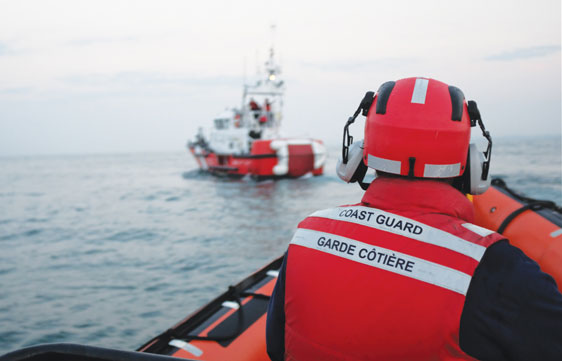
Nasty weather or an unexpected emergency can turn a pleasant day boating on Lake Ontario into a frightening ordeal. That’s when the Canadian Coast Guard Search and Rescue unit comes into play. They know the lake and its volatility; they understand urgency and they are well-trained.
IT’S EARLY MORNING – THREE A.M. – WHEN THE PHONE RINGS IN THE COBOURG COAST GUARD’S LAND BASE. Rob Moore, the Commanding Officer, snaps out of sleep. It’s an urgent call from the Joint Rescue Co-ordination Centre (JRCC) in Trenton with a ‘tasking’ for the Cobourg Search and Rescue crew. A boat is taking on water out on the lake. JRCC provides the details of the emergency – what sort of boat it is, its position, how many people are aboard, whether anyone is hurt or experiencing medical problems and, most importantly, whether the boat is taking on water and, if so, how quickly.
This time it’s a 26-foot cabin cruiser with a couple aboard, and she’s off Presqu’ile.
While Moore is on the phone, the rest of his crew – Mike Nicol and Jason Hicks, both Rescue Specialists, and Mat Jakuszyk, the engineer – are up, dressed and standing by to hear the details.
Within minutes, Moore is in his office and has located the position of the distressed boat on an electronic chart. The Cobourg station covers a large section of lake, extending from Oshawa to Point Petrie at the southern tip of Prince Edward County. Presqu’ile is 22 nautical miles, or close to 41 kilometres to the east, and it will take an hour to get there.
Instant decisions have to be made: Does the crew take the 754 – a very fast, light, rubber Zodiac rescue craft – or Cape Rescue, the 47-foot cutter which is slower but carries far more equipment on board. All the key variables race through Moore’s mind: the weather, the distance to the sinking boat, how fast it’s taking on water and how cold the water is – and on this early June morning, the water is still very cold.
The decision is made to take the cutter. If the boat in distress was farther away, the Trenton airbase would dispatch a Hercules plane or the Search and Rescue helicopter.
It takes the practiced crew no more than ten minutes to throw together their gear. They grab jackets packed with insulation – essential for the temperatures that are far colder out on the lake, even in summer and especially at night. All the rescue equipment is stowed on board and, as they ready the Cape Rescue for sailing, Moore inputs his co-ordinates and his course in the navigation computer and establishes an estimated time of arrival at the disaster site. Once underway, he radios the Prescott Coast Guard – the middle man between themselves and JRCC – requesting they relay a message to JRCC that they’re en route and they expect to arrive at the emergency site within the hour.
Moore is a bighearted man who exudes a quiet confidence. Although he describes himself as “not much of a talker”, his navy experience and his 17 years in the Coast Guard speak volumes.
The boat noses quietly out of the marina into the darkness, past the sleeping boats tied up at their moorings. Once beyond the lighthouse guarding the harbour entrance, Moore leans on the throttle and the boat’s twin 450 hp. Caterpillar engines roar into action, creating a great whale’s tail of foam behind her. Cape Rescue, a Bay Class, west-coast-built boat, is, at 10-years old, the newest Coast Guard boat on the Great Lakes with a top speed of 25 knots – in layman’s terms, that’s around 46 km/h. “You can go full ahead and change to full astern,” says Moore. “But,” he adds with a smile, “the engineer doesn’t like it!”.
In foul or bitterly cold weather, the best place to drive the Cape Rescue is in the enclosed bridge, but when on the lookout for a boat, as Moore and his unit are now, the open flybridge above it has the advantage of an unimpeded, 360° view.
Over the flybridge is an air-filled flotation tank which automatically rights the boat if it were ever to turn turtle, and above that is the constantly rotating radar, its beam indicating objects in the water.
In about an hour, the sinking cabin cruiser shows up on the radar, well before the crew sees it in the dark. Minutes later, they’re alongside and being welcomed by two visibly shaken, very cold, and greatly relieved owners who are up to their knees in water that is rising steadily.
Moore radios Prescott Coast Guard with an update. In this case, it’s a straightforward message – they are bringing the couple on board and pumping out their boat.
The crew tie the sinking cabin cruiser to Cape Rescue. Mike Nicol, one of the Rescue Specialists, checks the couple to make sure they’re all right. (Nicol was once a firefighter, so you could say he’s experienced rescue at both ends of the temperature spectrum). Apart from being frightened and very cold, the middle-aged couple are okay. Had they shown signs of hypothermia, Moore would have arranged for an emergency medical team to meet the boat. But right now, all that’s needed are dry clothes, warm blankets and a hot drink.
In the meantime, Nicol and Hicks have hauled a pump onto the cabin cruiser and have started pumping out the water. Moore keeps in radio contact with the Prescott unit, relaying statistics on the situation.
When the cabin cruiser is pumped out, the decision is made to take her back to Cobourg. But water is still coming in through a loose water intake pipe, so Nicol remains aboard with a radio while towing is underway, running the pump when necessary.
The journey back is slow and uneventful and the sun is up by the time Cobourg comes in sight. The cabin cruiser is secured on the far side of the Coast Guard dock, where it will be inspected by one of the marina’s mechanics. The crew records all the final pieces of information from the cabin cruiser and from the rescued couple – who won’t incur any of the costs associated with the incident – for their Search and Rescue report.
Then the unsung heroine of the piece, Cape Rescue, gets cleaned up and her gear properly stowed. She’s refuelled, all the used supplies replaced, and she’s poised and ready for the next emergency call.
Moore completes his Search and Rescue report, sends it to JRCC and all hands return to normal office duties. It’s 7 a.m.
THE COBOURG COAST GUARD STATION – one of the oldest of the nine stations on the Great Lakes, and one of the three on Lake Ontario – is tucked into a corner of the crowded Cobourg Marina along with 100 or so pleasure boats, angled off the long east pier.
The two Coast Guard boats – the red and white e, and the 754 Zodiac, the orange rescue dinghy, fitted with a radar arch at the stern end – are tied up at the pier. Each boat serves a specific purpose at a specific point of time. Moore elaborates: “The Zodiac is used for high speed rescues. A boy was in trouble in the outer harbour the other day and we didn’t have time for the big boat, so we used the Zodiac.” It looks small beside Cape Rescue, but at 24.5 feet, it’s as large as rubber dinghies get. On the dock, adjacent to the boats, is a small repair shed. Across the main East Pier are two white buildings – the Ready Locker and the Coast Guard living quarters. In between the two buildings is a trailer, which acts as the office for the Search and Rescue Unit.
But according to Moore, change is ahead. “In about a year, this is all coming down and we’re getting a new station. Everything will be under one roof.” He holds up an architect’s elevation. It’s not beautiful, but no doubt practicality will compensate for the new building’s lack of aesthetics. In the existing building, he shows off the living quarters with a kitchen and five bedrooms. There’s a good-sized living room with windows looking out over a grassy strip straight onto Cobourg’s beach – real estate worth millions, for which any developer would give their eye teeth.
Outside the living quarters, a large sign that reads, “This is a residence” warns away tourists who frequently walk up to the building, usually looking for a washroom, but sometimes just out of curiosity. Moore explains that “during the Waterfront Festival in July, it’s a zoo in the harbour area. We have special security at that time…There’s always something going on here.”
From late March on, two crews of four work in tandem at the station – two weeks on and two weeks off – until the unit closes down completely in mid-December when the St. Lawrence Seaway freezes up and the Great Lakes shipping shuts down. The Search and Rescue boats are stored at the Canadian Centre for Inland Waters dock in Burlington for the winter.
After a long, busy summer, Moore spends the winter months at home, where the sailor transforms into a hunter and fisherman every chance he gets. But, he admits, when spring rolls round, he’s ready to return to his command. His three boys – an eleven-year-old and nine-year-old twins – “don’t like to see me go, but they’re used to it.”
THE NAME ‘COAST GUARD’ SUGGESTS a protective role. Images of the rum runners who plied the waters of Lake Ontario during Prohibition come to mind. But those days are long gone. According to Moore, at one time the Coast Guard acted as an enforcement unit on the water but that role was turned over to the Marine Security Enforcements Team – a joint RCMP and Canadian Coast Guard unit that provides armed, on-the-water law enforcement for the Great Lakes and the St. Lawrence Seaway systems.
That said, if the Search and Rescue unit sees suspicious activity, they will take pictures and record the numbers off the boat in question and report their concerns to the security enforcement unit. Moore explains, “…we don’t get involved in security issues on the water. That’s not our job. We’re more like an ambulance.” Indeed, with the Rescue Specialists, the jump kit with first aid supplies and oxygen aboard, the Cape Rescue and the 754 Zodiac are like nautical ambulances.
Will the Coast Guard change in the future? “It has already changed,” Moore notes when he speaks about the role of his unit on the water. “But, I hope it doesn’t change much more.” Apparently drones were being tried out in places and unmanned vessels are out on the water, “but they’re running aground!”
We suspect robots won’t be stealing Rob Moore’s job any time soon.
Story by:
Patricia Beeson
Photography by:
Matthew Botha

